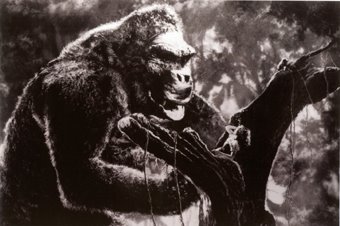
Production still from King Kong (1933)
'Like myths and fairytales, art and film encode cultural contradictions, moral dilemnas and dominant ideologies; they rewrite, re-vision and remake cultural fables, like that of Beauty and the Beast. In the period following the Enlightenment, the nature of aesthetic value and judgment changed. Modern art, literature and later film, illustrated the grotesque in order to define beauty, made monsters to delineate the bounds of normality, set beasts in opposition to humanity, and created racial others in order to construct a normative (white) subject.
When ideals of beauty were recognised as dependent on human appreciation, the grotesque emerged as a foil to beauty - and the thoroughly modern monster was born.
In 1927 Victor Hugo describes the grotesque and its relationship to beauty as the key to modern aesthetics: 'It is everywhere; on the one hand, it creates the deformed and the horrible, on the other the comic and the buffoon'. Serving as contrast to the sublime, the grotesque is placed at the vanguard of progress in the arts; it gives birth to a modern form of beauty made up of violent contrasts. On the grotesque he suggests further that: 'in the age of romaticism everything bears witness to its intimate and creative alliance with Beauty. Even the most naive popular legends explain at times with an admirable instinct this mystery of modern art. Antiquity would not have made Beauty and the Beast'. Precursors such as Apuleius's classical story of a divine lover mistaken for a monster do not rely in the same way on the visualisations of the grotesque and its contrast with beauty - Cupid is never really a beast.'
From 'It was beauty killed the beast': Modern Monsters from Frankenstein to King Kong by Kathryn Weir